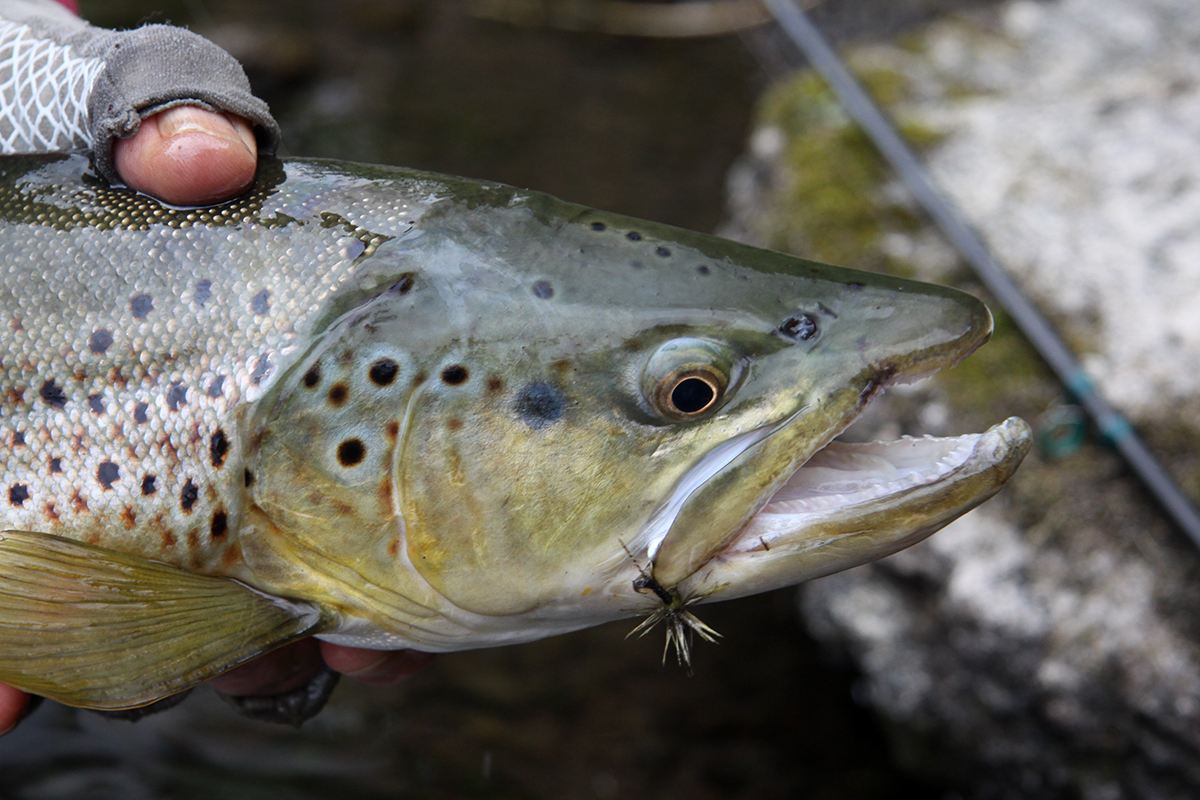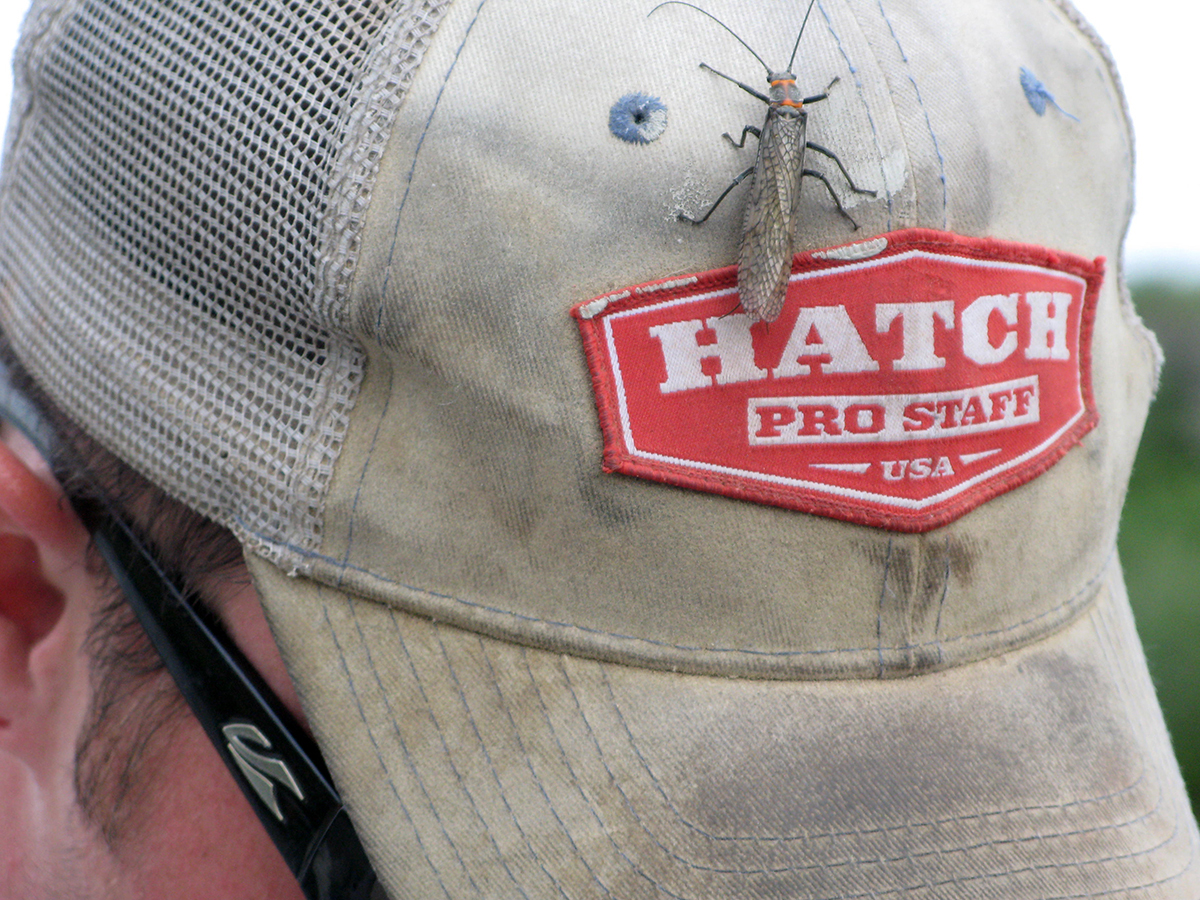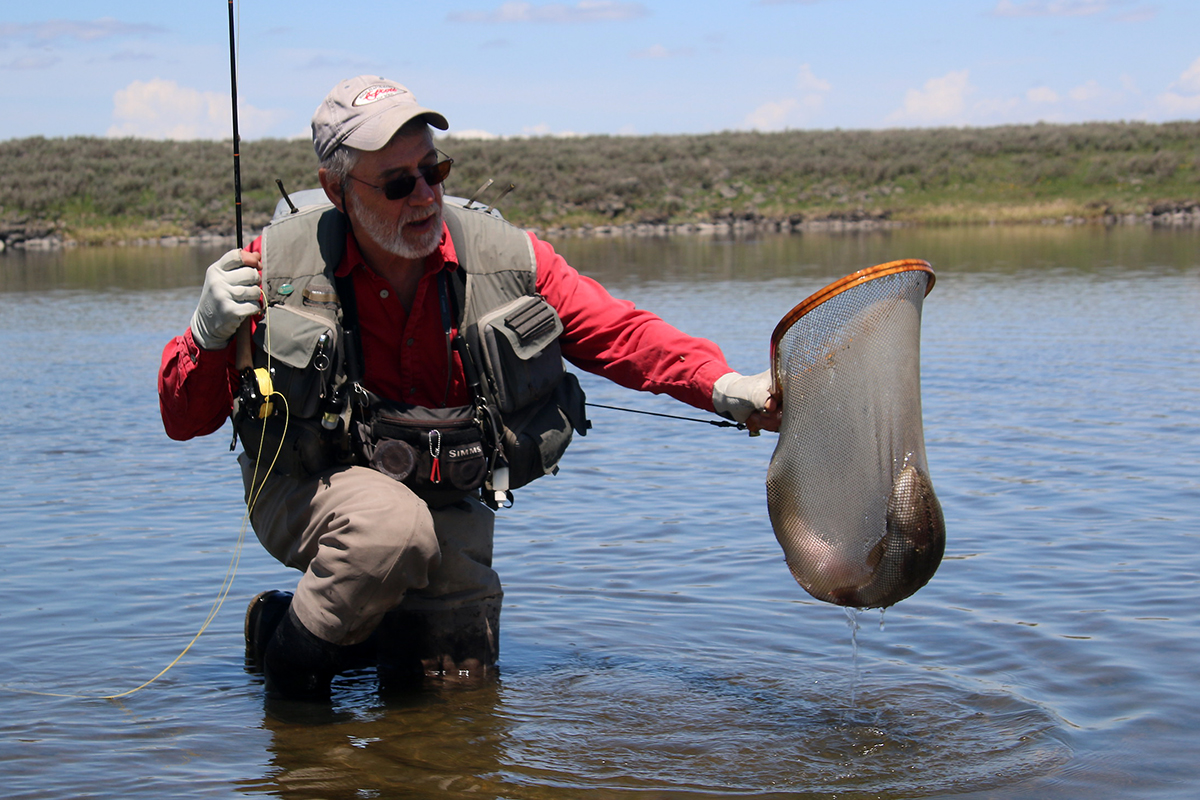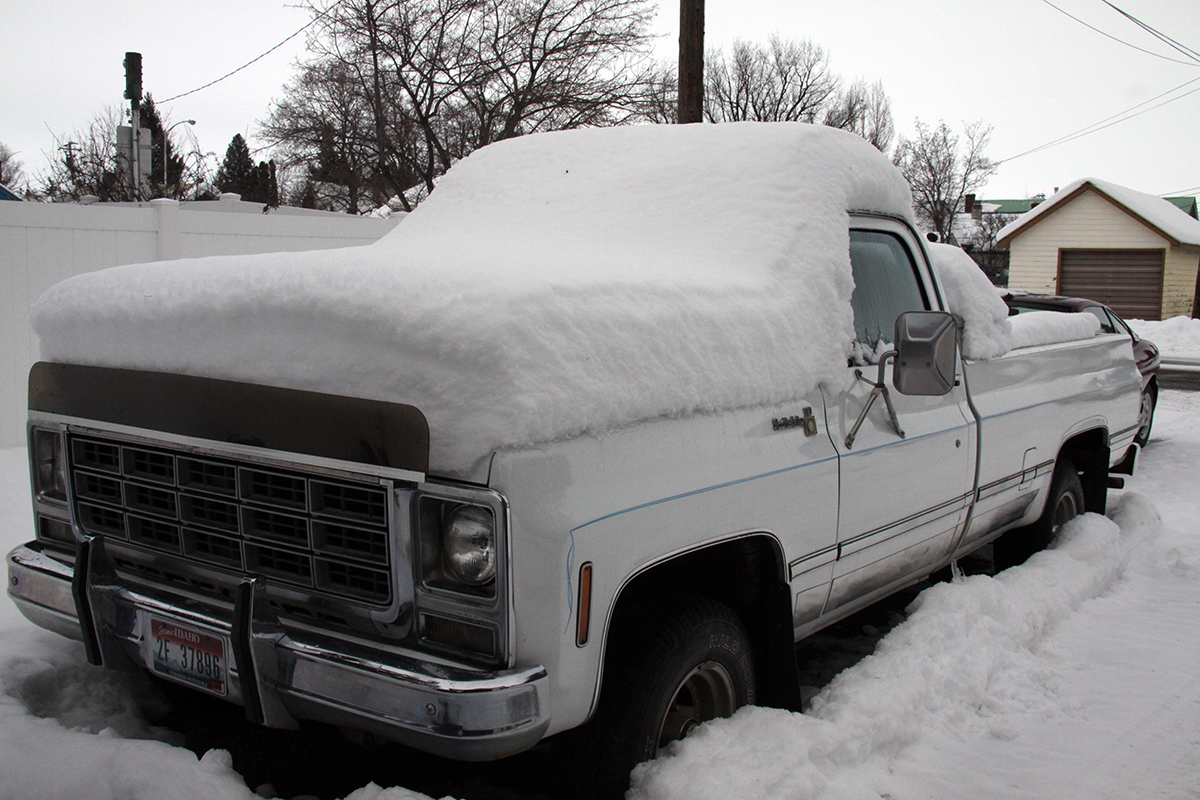In a winter rescued by late snow in March and April, flows on the Henry’s Fork met survival needs for trout and insects. And while short of the ideal levels of recent years, water managers and the Henry’s Fork Foundation deserve credit for considering the fishery at a time when low reservoir storage previously might not have been perceived as adequate for the release we saw last winter.
 Despite some serious icing in December, winter fishing in Last Chance was impressive enough to prompt a drive from St. Anthony on a number of days when I would normally be fishing the lower river. Fish could be found rising to midges nearly anytime the temperature would approach 40? F, and several enjoyable days in March were spent fishing the big Baetis with the TroutHunter guys. In April we were joined by our friend Gareth Jones from Wales, who did just fine despite a sudden snow storm that forced an early departure from Island Park.
Despite some serious icing in December, winter fishing in Last Chance was impressive enough to prompt a drive from St. Anthony on a number of days when I would normally be fishing the lower river. Fish could be found rising to midges nearly anytime the temperature would approach 40? F, and several enjoyable days in March were spent fishing the big Baetis with the TroutHunter guys. In April we were joined by our friend Gareth Jones from Wales, who did just fine despite a sudden snow storm that forced an early departure from Island Park.
A late snow melt delayed the annual return to our cabin in Last Chance, and a big blizzard accompanied the move on Mother’s Day weekend.
Mostly pleasant weather in May brought a continuation of Baetis fishing, which was bolstered by some excellent hatches of March Browns and plenty of early caddis. Noticeably absent, however, was the wonderful spring fishing on Henry’s Lake Outlet that we had enjoyed since year round fishing began a few years back. With Henry’s Lake drawn down extremely low due to the dry summer of 2013, flow into the outlet was shut completely off to allow refilling at the end of irrigation season. I’m guessing trout on the upper end were forced downstream where dewatering was prevented by tributaries crossing Henry’s Lake Flat from the Centennial Range and some minor springs. The good news is that trout in good numbers were again present in the upper outlet in the fall of 2014.
 With flows lower than ideal, float fishing during the Salmon Fly hatch in late May and early June suffered a bit as trout seemed to avoid the shallower banks in favor of deeper water at midstream. However, the hatch was solid and produced some memorable days on the lower river and again later above the falls and Box Canyon.
With flows lower than ideal, float fishing during the Salmon Fly hatch in late May and early June suffered a bit as trout seemed to avoid the shallower banks in favor of deeper water at midstream. However, the hatch was solid and produced some memorable days on the lower river and again later above the falls and Box Canyon.
Dry weather and a slow filling reservoir kept the water level unusually low until early July causing some concern for a negative impact on the fishery. This applied especially to the wider sections where the edges were reduced to bare stream bottom that extended 10 to 12 feet from the banks in some instances. While significant damage did not seem to occur, trying to approach a rising trout in ankle to knee deep water was a rather dubious proposition, especially before the development of seasonal aquatic vegetation. However, normal hatching patterns did not seem to be significantly altered by the unique conditions, and those who adjusted were rewarded with some fine fishing during this period. Extra caution and determination in the approach combined with deft casting at beyond comfortable range at times would often result in trout of impressive length and condition.
Bibio and Black Ants brought fish to the surface at the beginning of June, and caddis hatches remained consistent throughout the month. March Browns and Baetis were replaced by the timely appearance of PMDs, Brown Drakes, Green Drakes, and Flavs.
The 30th Anniversary Celebration of the Henry’s Fork Foundation coincided with the Ranch opener on June 15, and neither event was a disappointment to the larger than usual crowd.
 Although late in arriving, typical summer flows brought improved conditions in the Ranch where they are most important, and the weather remained warm, dry, and pleasant until mid-July. Concerns for a repeat of near draught conditions similar to 2013 were relieved by a trend of wet weather that began at this time and continued through much of October. And while disruptive at times, the abundance of cooler temperatures and gray, wet days were in total contrast to what is normally experienced during the hottest part of the season. Excluding times of extremely heavy rainfall, these conditions were perfect for mid-summer hatches of Callibaetis, Trico, and Gray Drakes. Both PMDs and caddis continued into September when they were deposed by strong hatches of Mahogany Duns and Baetis. Fortunately, there were enough bright, warm days to permit good showings of winged ants, beetles, and other terrestrials.
Although late in arriving, typical summer flows brought improved conditions in the Ranch where they are most important, and the weather remained warm, dry, and pleasant until mid-July. Concerns for a repeat of near draught conditions similar to 2013 were relieved by a trend of wet weather that began at this time and continued through much of October. And while disruptive at times, the abundance of cooler temperatures and gray, wet days were in total contrast to what is normally experienced during the hottest part of the season. Excluding times of extremely heavy rainfall, these conditions were perfect for mid-summer hatches of Callibaetis, Trico, and Gray Drakes. Both PMDs and caddis continued into September when they were deposed by strong hatches of Mahogany Duns and Baetis. Fortunately, there were enough bright, warm days to permit good showings of winged ants, beetles, and other terrestrials.
Local still waters like Henry’s, Hebgen, and Sheridan Lakes fished especially well from mid-summer until well into the fall. This was primarily due to stable water levels and conditions that triggered strong availability of Damsels, Callibaetis, and other insects unique to this type of fishery. However, rain often accompanied by strong breezes did limit those days that are perfect to be on still water when compared to a typical year.
Raw weather days from late September through mid-October were not a handicap for fall Baetis hatches on the river. A chilled wind and frequent rain did not deter the trout or the Baetis on many days when one indifferent to physical comfort could have the water nearly to himself.
The most pleasant weather of autumn made it tough to leave Island Park in late October. It is at this time that my mind always turns toward streamer fishing and big brown trout on the lower Fork. Despite bright conditions and unusually warm temperatures, I enjoyed more than two weeks of productive fishing with my family, but an abrupt weather change brought an end to it all in mid-November.
The week before Thanksgiving found the river frozen over in the slower sections and slush ice flowed daily through the end of the month. Combined with early snow, the subzero temperatures caused one to think that January had arrived six weeks early on the Henry’s Fork. Fortunately this arctic surge was displaced by relatively warm conditions that allowed some respectable midge fishing until the week before Christmas.
A week of heavy snow followed by a similar period of extremely cold temperatures brought an end to a year as strange as any I can remember in terms of weather extremes. Never do I recall a year when precipitation in the form of rain was nearly equal to snowfall in the Henry’s Fork Drainage, but that is what we experienced in 2014. The sustained subzero temperatures of November were equally rare, as were the 50 plus degree days in December. Through it all, however, fishing was generally equal to the past few years, which most would consider excellent.
 We enter the New Year with much to be grateful for with respect to conditions that will drive the health of our fisheries in 2015. Reservoir storage benefitting from timely rainfall in 2014 stands at about 77% in Island Park and expectations are that it will fill as early as April. This leads to the hope that winter flows currently lower than is ideal can be improved during the cold months that lie ahead. Forecasters predict normal precipitation through the remainder of winter, which should preserve the status of a snow pack that currently stands at about 110% of average.
We enter the New Year with much to be grateful for with respect to conditions that will drive the health of our fisheries in 2015. Reservoir storage benefitting from timely rainfall in 2014 stands at about 77% in Island Park and expectations are that it will fill as early as April. This leads to the hope that winter flows currently lower than is ideal can be improved during the cold months that lie ahead. Forecasters predict normal precipitation through the remainder of winter, which should preserve the status of a snow pack that currently stands at about 110% of average.
My greatest concern at this time is that current flows of less than 300 cfs below Island Park Dam will not completely insulate the fishery in the event of multiple days of severe subzero temperatures. Fortunately, the long range forecast does not predict unusually cold conditions as winter continues.
Deep winter is a waiting game at high elevation, and that is happening as I look at two feet of snow outside my St. Anthony studio. There is more in the immediate forecast and this is the best news as I look forward to another year on the Henry’s Fork.
Words by René Harrop. Photos by Bonnie Harrop.

1 Comment
Valerie
2014 was certainly a strange year for me too. I think the weather had a unique effect on many different things like my fishing and travel plans that had to be cancelled. Hopefully, 2015 will be more normal for both of us. Always love hearing your perspective on things.